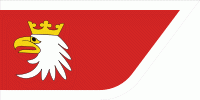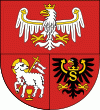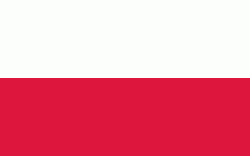Warmian-Masurian Voivodeship (Warmian-Masurian Voivodeship)
 |
 |
The Warmian-Masurian Voivodeship was created on 1 January 1999, from the entire Olsztyn Voivodeship, the western half of Suwałki Voivodeship and part of Elbląg Voivodeship, pursuant to the Polish local government reforms adopted in 1998. The province's name derives from two historic regions, Warmia and Masuria.
The province borders the Podlaskie Voivodeship to the east, the Masovian Voivodeship to the south, the Kuyavian-Pomeranian Voivodeship to the south-west, the Pomeranian Voivodeship to the west, the Vistula Lagoon to the northwest, and the Kaliningrad Oblast (an exclave of Russia) to the north. Its borders largely overlap with the southern two-thirds of former East Prussia, which was assigned to Poland after World War II.
The region was originally inhabited by the Old Prussian clan of the Warmians from whom the name Warmia originated. During the northern Crusade, the Old Prussians were conquered by the Teutonic Order and their land was granted to the order by the pope and the region became part of the State of the Teutonic Order. The Order encouraged the colonization by German settlers in Warmia (Ostsiedlung) and Polish colonists from the region of Masovia, called Masurians (Mazurzy), hence the name Masuria. The Old Prussians became assimilated into the newcomers and thus became extinct. During the Teutonic rule, the region experienced a process of urbanization and economic boost due to the expansion of the Hanseatic League into the region. The Order later attacked their former ally Poland and conquered the region of Pomerelia, thus entered a long-lasting conflict with Poland, which subsequently entered an alliance with Lithuania. In Masuria, the Poles and Lithuanians defeated the Order at the Battle of Grunwald. The wars finally resulted in a rebellion of the urban population of Pomerelia and Warmia, who were affected by the Teuton's numerous wars; upon their request the region was incorporated to Poland by King Casimir IV Jagiellon, and after the Thirteen Years' War it remained under Polish suzerainty, but was divided into two parts: Elbląg and Warmia were incorporated directly into the Kingdom of Poland, Masuria became a Polish fief under the control of the Teutonic Order. The state of the Teutonic Order ceased to exist in 1525 when Grandmaster Albert Hohenzollern introduced secularisation, proclaimed the Duchy of Prussia and became a vassal of Sigismund I of Poland. The Prussian line of Hohenzollern was extinct by 1618 with the death of Albert Frederick and the Duchy was inherited by the Brandenburgian line; Prussia simultaneously entered a personal union with the electorate of Brandenburg known as Brandenburg-Prussia, remaining under Polish suzerainty until the Treaty of Oliva in 1660. The throne was inherited by Frederick I of Prussia who wanted to unite the Duchy with Brandenburg and also wanted to proclaim himself king of Prussia and therefore participated in the Russian-initiated Partitions of Poland in which Warmia was annexed by the Kingdom of Prussia, and henceforth became part of the newly established province of East Prussia until 1945. Together with the rest of the Kingdom, the region became part of the North German Confederation, the German Empire, the Weimar Republic, and Nazi Germany. After the end of World War II, both the German as well as the Slavic Masurian population were expelled by the Polish government. In 1914, the province turned into a battlefield, seeing notable battles such as the Battle of Tannenberg as part of the Eastern Front of World War I. Amongst the most visited sights is the Masurian Lake District, which contains more than 2,000 lakes, including the largest lakes of Poland, Śniardwy and Mamry. Other recognizable landmarks are the Warmian castles (Lidzbark Warmiński Castle, Pieniężno Castle, Olsztyn Castle) and the Cathedral Hill in Frombork, where Polish astronomer Nicolaus Copernicus lived and worked. The Lidzbark Warmiński Castle was later the residence of Ignacy Krasicki, nicknamed the Prince of Polish Poets. The Grunwald battlefield in Masuria is site of the annual reenactment of one of the largest battles of Medieval Europe. Święta Lipka in Masuria and Gietrzwałd in Warmia are popular pilgrimage sites.
The Warmian–Masurian Voivodeship has the largest number of ethnic Ukrainians living in Poland due to forced relocations (such as Operation Vistula) carried out by the Soviet and Polish Communist authorities.
Map - Warmian-Masurian Voivodeship (Warmian-Masurian Voivodeship)
Map
Country - Poland
 |
 |
| Flag of Poland | |
Poland has a temperate transitional climate and its territory traverses the Central European Plain, extending from Baltic Sea in the north to Sudeten and Carpathian Mountains in the south. The longest Polish river is the Vistula, and Poland's highest point is Mount Rysy, situated in the Tatra mountain range of the Carpathians. The country is bordered by Lithuania and Russia to the northeast, Belarus and Ukraine to the east, Slovakia and the Czech Republic to the south, and Germany to the west. It also shares maritime boundaries with Denmark and Sweden.
Currency / Language
| ISO | Currency | Symbol | Significant figures |
|---|---|---|---|
| PLN | Polish złoty | zÅ‚ | 2 |
| ISO | Language |
|---|---|
| PL | Polish language |

































